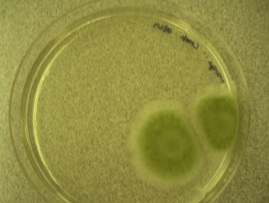
Features
Production
Research
Study reviews ways to prevent fruit spoilage
June 25, 2009 By Marg Land
 June 25, 2009 – A recent study compiles the results of different
June 25, 2009 – A recent study compiles the results of different
research on the use of natural antimicrobials in fresh-cut fruits and
juices to maintain their safety and quality.
June 25, 2009 – A recent study compiles the results of different research on the use of natural antimicrobials in fresh-cut fruits and juices to maintain their safety and quality.
 |
|
| Penicillium expansum or blue mould |
Consumption of ready-to-eat fruits that are fresh-cut and fruit juices has substantially risen over the last few years, mostly due to the increasing demand for low-calorie food products with fresh-like characteristics.
As a consequence of inappropriate manipulation and storage conditions, both pathogenic and/or deteriorative microorganisms may contaminate a produce, thus increasing the risk of microbial diseases and spoilage.
Whole fresh fruits before processing are washed with water containing chemical sanitizer agents, such as chlorine dioxide or hydrogen peroxide, to decontaminate the surface of the fruit. Organic acids have been traditionally used in the food industry as preservative agents, since pH has a great impact on the survival and growth of microorganisms in foods.
Different studies examined in the article, published by the Institute of Food Technologists in the journal Comprehensive Reviews in Food Science and Food Safety, have demonstrated the effectiveness of organic acids added to fresh-cut fruits and fruit juices. It has been shown that the use of organic acids in combination with other preservation methods such as mild heat, freezing-thawing or dehydration has an enhanced antimicrobial effect in fresh-cut fruits and/or fruit juices.
“The different natural antimicrobials of animal, plant, and microbial origin, directly or indirectly added to fresh-cut fruits and fruit juices, can effectively reduce or inhibit pathogenic and spoilage microorganisms, thus representing a good alternative to the use of traditional antimicrobials,” says lead researcher Olga Martin-Belloso of the University of Lleida in Spain. “However, the extraction and purification of some natural antimicrobials can be difficult, and expensive isolation and purification procedures that may avoid denaturalization, breakdown, volatilization, and/or loss of functional properties of active compounds, as well as safety and toxicology evaluations, could be implicated.
The effectiveness of natural antimicrobial substances added to fruit derivatives has been studied by different researchers. Natural antimicrobials of animal origin include lactoperoxidase, which is present in milk and has antimicrobial effects against bacteria, fungi and viruses. Plant-based antimicrobials include essential oils. Antimicrobials of animal, plant, and microbial origin can be used to effectively reduce pathogenic and spoilage microorganisms in fresh-cut fruits and fruit juices.
The use of these compounds at a commercial level is still limited due to several factors such as impact on sensory attributes or in some cases, regulatory issues concerning their use. Extensive research on the effects of each antimicrobial on food sensory characteristics is still needed so that antimicrobial substances of natural origin can be regarded as feasible alternatives to synthetic ones.
“The addition of antimicrobials without adversely affecting the sensory characteristics is still a challenge for researchers, since the concentrations that are necessary to ensure safety of fresh-cut fruits and fruit juices are several times higher than those accepted by consumers from a sensory point of view,” writes Martin-Belloso. “Therefore, new studies combining the use of antimicrobials with other methodologies or food preservation are necessary to reduce the impact of these compounds on sensory properties.”
To read the research paper, click here.
Print this page